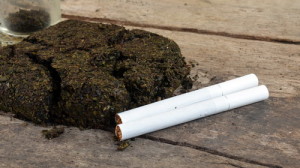Smoking Marijuana is now becoming more acceptable in the Western Hemisphere and unlike normal cigarettes, the ‘Joint’ is now on its way to being sold everywhere there is need for it due to its supposed medicinal effects. Depending on its geographical location, marijuana comes with different names such as Ganja, Igbo, Joint, Weed, Pot, Cannabis and so on.
 Marijuana remains a taboo in most African homes due to their coveted conservative and family-oriented culture. Smoking marijuana will be a great concern for any family, a mother’s worst fear is realized when she found out that her son is an ‘Igbo’ smoker.
Marijuana remains a taboo in most African homes due to their coveted conservative and family-oriented culture. Smoking marijuana will be a great concern for any family, a mother’s worst fear is realized when she found out that her son is an ‘Igbo’ smoker.
In the West, it is just another alternative lifestyle, people considered it as not really a big deal and smoke it freely. Some people in the West (now becoming a minority) are still raising concerns about the dangers of ‘weed’ smoking. They were of the opinion that it could open the ‘gates’ for other forms of drug abuse like cocaine, heroin and ecstasy addiction. They contended that the so called medicinal benefits of marijuana have been exaggerated by an ever increasing weed-friendly media.
In four American states, Colorado, Washington, Alaska, and Oregon, the sale and possession of marijuana is legal for both medical and recreational use; and Washington DC legalized it only for personal use but not for commercial sale. The rest of the world is watching these developments keenly due to the American mass media backed cultural influence.
Other countries are contemplating making similar legislation. There have been debates about marijuana legislation in the Caribbean states such as Jamaica, Guyana etc. Even the new Canadian Prime Minister, Justine Trudeau, made the issue of marijuana legislation a campaign promise before he was elected into office but is yet to enact any policy due to concerns from the police and some interest groups. Back in the days, marijuana acceptance and legalization were once spearheaded and made popular by reggae’s top icons – Bob Marley and Peter Tosh in their music.
One thing that borders me about the arguments being put forward by the marijuana proponents is the notion of huge amount of revenue that could be generated from its legislation and subsequent commercialization. They were of the opinion that such legislation would help reduce or eradicate its underground criminal activities, create jobs and thus stimulates the local economy. The problem here is that the same argument can be proposed and applied to other kinds of currently banned illegal substances like cocaine and heroin in the name of revenue generation. Cocaine by itself is over a billion dollar underground industry in the central and South Americas.
My main concern here is the kind of society we are cultivating if everybody is allowed to puff weed? Could there be a limit to the Western concept of “freedom of Expression”? Back then in Nigeria, I have witnessed people whose life were either nearly destroyed or totally messed up by weed consumption.
Do you agree that marijuana should be allowed to be taken freely in your society or remained banned? Now let’s get to know what this marijuana is and what people have been saying about it.
According to Dr. Harold Gladwell, Marijuana is the common name for a crude drug made from the plant called Cannabis sativa. It is a green, brown, or gray mixture of dried, shredded leaves, stems, seeds, and flowers of this plant. Other forms of cannabis include
Active components
Marijuana is composed mainly by an active ingredient called delta-9-tetrahydrocannabinol (THC) – a very strong psychoactive substance. This substance is responsible for the potency and effects of marijuana intoxication. Different types of marijuana have different levels of THC in it, many Africans living in Europe believed the African version is more potent than the one made in Europe.
Other active components:
Cannabinol and cannabidiol: These compounds have some of the properties of THC, but cause less psychoactive effects.
Dronabinol (Marinol): a man-made version of THC available by prescription. It’s used to prevent nausea and vomiting after cancer chemotherapy and to increase appetite in people with AIDS.
Mechanism of action
When smoked or ingested, THC and other active components that can be found in marijuana are targeting and attaching to two types of receptors on the cells in the body.
CB1 receptors
These receptors are found mainly in the brain, especially in the areas that control body movement, memory and vomiting. This is why marijuana affects balance and coordination and impairs short-term memory and learning, and why it can be useful in treating nausea, pain and the loss of appetite.
CB2 receptors
These receptors are found mainly in the immune system tissue, such as your spleen and lymph nodes, although in much smaller numbers. The function of these receptors is not well understood.
The Pros and Cons of Marijuana Usage
|
PRO Medical Marijuana |
CON Medical Marijuana
|
|
Physician Perspectives on Marijuana’s Medical Use |
|
| “The evidence is overwhelming that marijuana can relieve certain types of pain, nausea, vomiting and other symptoms caused by such illnesses as multiple sclerosis, cancer and AIDS — or by the harsh drugs sometimes used to treat them. And it can do so with remarkable safety. Indeed, marijuana is less toxic than many of the drugs that physicians prescribe every day.”
— Joycelyn Elders, MD |
“Although I understand many believe marijuana is the most effective drug in combating their medical ailments, I would caution against this assumption due to the lack of consistent, repeatable scientific data available to prove marijuana’s medical benefits.
Based on current evidence, I believe that marijuana is a dangerous drug and that there are less dangerous medicines offering the same relief from pain and other medical symptoms.” — Bill Frist, MD |
|
Medical Organizations’ Opinions |
|
| “ACP urges review of marijuana’s status as a schedule I controlled substance and its reclassification into a more appropriate schedule, given the scientific evidence regarding marijuana’s safety and efficacy in some clinical conditions…
ACP strongly supports exemption from federal criminal prosecution; civil liability; or professional sanctioning, such as loss of licensure or credentialing, for physicians who prescribe or dispense medical marijuana in accordance with state law. Similarly, ACP strongly urges protection from criminal or civil penalties for patients who use medical marijuana as permitted under state laws.” — American College of Physicians |
“In an effort to determine whether marijuana, or drugs derived from marijuana, might be effective as a glaucoma treatment, the National Eye Institute (NEI) supported research studies beginning in 1978… However, none of these studies demonstrated that marijuana — or any of its components — could lower IOP [intraocular pressure]as effectively as drugs already on the market. In addition, some potentially serious side effects were noted, including an increased heart rate and a decrease in blood pressure in studies using smoked marijuana.
The identification of side effects from smoked marijuana, coupled with the emergence of highly effective FDA-approved medications for glaucoma treatment, may have led to diminished interest in this research area.”
— National Eye Institute |
|
US Government Officials’ Views |
|
| “The evidence in this record [9-6-88 ruling] clearly shows that marijuana has been accepted as capable of relieving the distress of great numbers of very ill people, and doing so with safety under medical supervision. It would be unreasonable, arbitrary and capricious for DEA to continue to stand between those sufferers and the benefits of this substance in light of the evidence in this record.”
— Judge Francis L. Young |
“Smoked marijuana damages the brain, heart, lungs, and immune system. It impairs learning and interferes with memory, perception, and judgment. Smoked marijuana contains cancer-causing compounds and has been implicated in a high percentage of automobile crashes and workplace accidents.”
— John Walters |
|
Health Risks of Smoked Marijuana |
|
| “There is very little evidence that smoking marijuana as a means of taking it represents a significant health risk.
Although cannabis has been smoked widely in Western countries for more than four decades, there have been no reported cases of lung cancer or emphysema attributed to marijuana. I suspect that a day’s breathing in any city with poor air quality poses more of a threat than inhaling a day’s dose — which for many ailments is just a portion of a joint — of marijuana.” — Lester Grinspoon, MD |
“3-4 Cannabis cigarettes a day are associated with the same evidence of acute and chronic bronchitis and the same degree of damage to the bronchial mucosa as 20 or more tobacco cigarettes a day.
Cannabis smoking is likely to weaken the immune system. Infections of the lung are due to a combination of smoking-related damage to the cells lining the bronchial passage and impairment of the principal immune cells in the small air sacs caused by cannabis.” — British Lung Foundation |
|
Treating AIDS with Marijuana |
|
| “Patients receiving cannabinoids [smoked marijuana and marijuana pills]had improved immune function compared with those receiving placebo. They also gained about 4 pounds more on average than those patients receiving placebo.”
— Donald Abrams, MD, et al. |
“The most compelling concerns regarding marijuana smoking in HIV/AIDS patients are the possible effects of marijuana on immunity.
Reports of opportunistic fungal and bacterial pneumonia in AIDS patients who used marijuana suggest that marijuana smoking either suppresses the immune system or exposes patients to an added burden of pathogens. In summary, patients with preexisting immune deficits due to AIDS should be expected to be vulnerable to serious harm caused by smoking marijuana.” — Institute of Medicine Report |
|
Marijuana For the Terminally Ill |
|
| “Consumer Reports believes that, for patients with advanced AIDS and terminal cancer, the apparent benefits some derive from smoking marijuana outweigh any substantiated or even suspected risks.
In the same spirit the FDA uses to hasten the approval of cancer drugs, federal laws should be relaxed in favor of states’ rights to allow physicians to administer marijuana to their patients on a caring and compassionate basis.” — Consumer Reports |
“The use of marijuana for the terminally ill can no longer be considered a therapeutic intervention but one of several procedures used to ease the ebbing of life of the terminally ill.
But for this purpose doctors should prescribe antiemetic and analgesic therapies of proven efficacy, rather than marijuana smoking. This therapeutic course is not based on bureaucratic absolutism, political correctness, or reflexive ideology – but on scientific knowledge and the humane practice of medicine.” — Gabriel Nahas, MD, PhD |
|
Marijuana vs. Marinol |
|
| “There are really no other medications that have the same mechanisms of action as marijuana. Dronabinol (Marinol) is available by prescription in capsules, but has the distinct disadvantage of containing only synthetic delta-9-tetrahydrocannabinol (THC) which is only one of many therapeutically beneficial cannabinoids in the natural plant.”
— Gregory T. Carter, MD |
“Marinol differs from the crude plant marijuana because it consists of one pure, well-studied, FDA-approved pharmaceutical in stable known dosages. Marijuana is an unstable mixture of over 400 chemicals including many toxic psychoactive chemicals which are largely unstudied and appear in uncontrolled strengths.”
— California Narcotics Officers Association |
|
Addictiveness of Marijuana |
|
| “For some users, perhaps as many as 10 per cent, cannabis leads to psychological dependence, but there is scant evidence that it carries a risk of true addiction. Unlike cigarette smokers, most users do not take the drug on a daily basis, and usually abandon it in their twenties or thirties.
Unlike for nicotine, alcohol and hard drugs, there is no clearly defined withdrawal syndrome, the hallmark of true addiction, when use is stopped.” — Colin Blakemore, PhD |
“This study validated several specific effects of marijuana abstinence in heavy marijuana users, and showed they were reliable and clinically significant.
These withdrawal effects appear similar in type and magnitude to those observed in studies of nicotine withdrawal […] Craving for marijuana, decreased appetite, sleep difficulty, and weight loss reliably changed across the smoking and abstinence phases. Aggression, anger, irritability, restlessness, and strange dreams increased significantly during one abstinence phase, but not the other.” —Alan J. Budney, PhD et al. |
|
“Gateway” Effect |
|
| “We’ve shown that the marijuana gateway effect is not the best explanation for the link between marijuana use and the use of harder drugs.
An alternative, simpler and more compelling explanation accounts for the pattern of drug use you see in this country, without resort to any gateway effects. While the gateway theory has enjoyed popular acceptance, scientists have always had their doubts. Our study shows that these doubts are justified. The people who are predisposed to use drugs and have the opportunity to use drugs are more likely than others to use both marijuana and harder drugs. Marijuana typically comes first because it is more available.” — Andrew Morral, PhD |
“A new federal report released today concludes the younger children are when they first use marijuana, the more likely they are to use cocaine and heroin and become dependent on drugs as adults.
Increases in the likelihood of cocaine and heroin use and drug dependence are also apparent for those who initiate use of marijuana at any later age” —US Substance Abuse and Mental Health Services Administration (SAMHSA) |
|
Medical Marijuana Debate and Its Effect on Youth Drug Use |
|
| “While it is not possible with existing data to determine conclusively that state medical marijuana laws caused the documented declines in adolescent marijuana use, the overwhelming downward trend strongly suggests that the effect of state medical marijuana laws on teen marijuana use has been either neutral or positive, discouraging youthful experimentation with the drug.”
— Mitch Earleywine, PhD |
“By characterizing the use of illegal drugs as quasi-legal, state-sanctioned, Saturday afternoon fun, legalizers destabilize the societal norm that drug use is dangerous. They undercut the goals of stopping the initiation of drug use to prevent addiction…. Children entering drug abuse treatment routinely report that they heard that ‘pot is medicine’ and, therefore, believed it to be good for them.”
— Andrea Barthwell, MD
Source: ©ProCon.org |
| PRO Medical Marijuana |
CON Medical Marijuana
|



